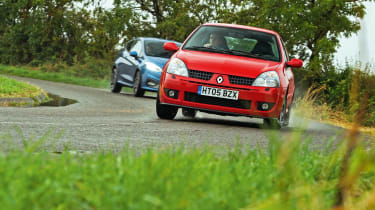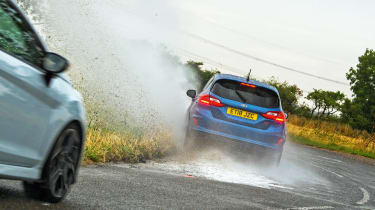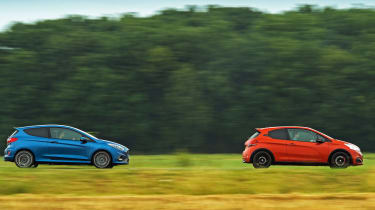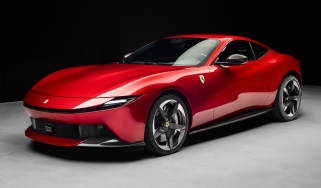New Ford Fiesta ST vs hot hatch greats - can it stand up to the very best?
It's crunch time for Ford's new Fiesta ST as it squares up to its predecessors, and Peugeot's 208 GTi by PS and Renault Sport's Clio Trophy
Hard act to follow, the old Ford Fiesta ST. Previous hot Fiestas were patchy affairs, but the ST of 2013-2017 was Ford returning to the top of its game. With the good fortune to coincide with a rare lapse from Renault Sport with the auto-only Clio 200 and average efforts from the likes of Volkswagen, Mini and Peugeot, that ST was an easy class leader. Affordable too, which is at least part of the reason why every second Fiesta you see seems to be one.
Officially it’s one in ten, and if Ford has got its sums right the latest ST should match that figure. On early evidence, there’s little reason why it shouldn’t: the new car is heaps of fun, even quicker than its predecessor, and remains competitively priced, at £18,995 – though more than two-thirds of ST buyers will shell out at least £21,495 for the ST-3 with its satnav and leather trim, and more than a fifth of those will throw in the Performance Pack for £850, with its a Quaife limited-slip differential, launch control and shift lights.
> Ford Fiesta ST review – simple, honest fun
Once again – for the time being at least – the Fiesta ST finds itself short of credible rivals on the new-car market. So to get a clearer picture of what this latest version is capable of we’re pitching it against three former evo supermini heroes. First, and perhaps most intriguing, is the aforementioned previous-generation ST, here in run-out ST200 form. This received an on-overboost power hike from 197bhp (a figure matched by the new car’s three-cylinder engine) to 212bhp, along with tweaked suspension in the form of softer springs and dampers, but a stiffer rear torsion beam and thicker rear anti-roll bar. Sophisticated? Nope. Fun? Plenty.

Next up is the Peugeot 208 GTi by Peugeot Sport, evo’s supermini class leader until the model went off sale a few months ago. Like the Performance Pack ST we’re testing here, the 205bhp Pug also gets a slippy diff, and it’s backed up by one of the most aggressive chassis we’ve seen in a front-driver, with throttle adjustability to make a 205 GTi cock a wheel in appreciation.
Last time we drove the 208 (evo 247) its stubby nose was bloodied by perhaps the best hot hatch ever to emerge from France – the Clio 200 Cup. I say ‘perhaps’ because the Cup’s predecessor, the limited-edition Trophy version of the Clio 182, is considered by many to be even better, and so by definition is among the greatest of the breed. It completes our gathering here.
So if the new Fiesta ST can beat any of these past masters it’ll deserve a place among the greats. However, all of our contenders face an extra challenge today: the weather. It’s raining for the first time in well over a month and some stretches of road might as well be covered in ball bearings for all the friction they offer. But with the key to the Trophy in my hand the day is already looking brighter. It’s the only one of our quartet I’ve never driven, but its reputation has me buzzing in anticipation.
It feels tiny. Not quite as bijou as my 106 Rallye, but it’s still nine inches shorter and four inches narrower than the new ST, and compared to the other three it’s blissfully devoid of overwrought details. The multi-spoke Speedlines look like they’ve been half-inched from a BTCC pitlane, while a small front lip and the Clio V6’s slightly taller rear spoiler offer clues for the connoisseur, should they somehow miss the Trophy lettering along the sills.
Neither bus-like steering wheel nor high-mounted Recaros are as troublesome as they might sound. As a person of modest height I prefer a slightly higher driving position anyway, and the wheel’s angle improves as it drops. The cabin feels snug, but the view from my perch past the matchstick pillars and over the low scuttle immediately brings me closer to the road.
The Trophy chunters into an industrial-sounding idle, one unaugmented by sound generators. The naturally aspirated 2-litre engine’s response to blips of the throttle is synaptic and the clutch has the heft of a Porsche Motorsport product. An exploratory squeeze of the brake pedal reveals half an inch of play followed by a firm and progressive action. Pretty much perfect.
Without turbocharging there’s a risk the old F4R four-cylinder could feel wheezy in a modern context. True, it isn’t as rampant as the other units from low revs, but nor is its power wasted on lost traction. The Trophy is also one of the lighter cars here and has close gearing, all of which combine to make you wonder whether the others’ extra brawn is desirable, or merely effective. There’s a gloriously slick feeling to the entire drivetrain, too, the sharp throttle, slightly notchy gearshift and calf-pumping clutch all gelling as you chase each red-line hit.
You’ll know already that the remote-reservoir Sachs dampers contribute to the genial chassis, but you’ll excuse us for delving into it once again. Body control is exceptional. It’s firm from the outset but never punishing, and once you’re at more than a saunter you feel exactly where the dampers stop reacting to bumps and begin to absorb them, only improving as you squeeze the tyres further into the tarmac.
Composure through mid-corner bumps is remarkable. Dips and compressions are simply dismissed, the Trophy refusing to break step unless you’re traversing lumps that force the tyres to lose contact with the road surface.
As well as control, those dampers help the Clio extract outstanding grip from the rubber. ‘The grip as you turn in feels limitless,’ says staff writer Will Beaumont. While you can overpower the front tyres if you jump on the throttle out of a tight corner, the noisy F4R lets you meter out power to the finest degree. At that point, you can simply enjoy the endless roadholding, garrulous steering and adjustable balance.
Stepping into the Peugeot is not a disappointment, even after the Trophy. Beaumont has it down as the winner right from the outset, still pining for his old long-termer and gushing over its hilariously lively chassis. He likens it to the dynamic instability of a modern jet fighter, the entire chassis edgy and almost unbalanced for maximum response, accentuated by sharp brakes that press the nose into the ground and give the tail end a helping hand.
In the dry this means front-end response and turn-in grip that few cars of any sort can match, amplified by the response of the video-game-sized steering wheel, but in the wet it can give you white knuckles and make you take notice of a car many would dismiss – wrongly – as a tarted-up city car.
As with the Clio, wheel control is never an issue, but one thing we don’t expect is that the 208 feels the softest and least compromised of all four cars, the firm ride smothering harsh edges that the others, particularly the Fords, seem to highlight.
That said, the ST200 feels more pliant than any other ST I’ve driven. Those spring and damper changes really work – had the ST been this easy-going from the start, it would have made things much trickier for Peugeot Sport. Where once the ST bounced from lump to bump and required a box of paracetamol in the glovebox on long trips, the ST200 feels… well, jolly firm still, but no longer agonisingly so.
It’s not an old car but there’s an old-school vibe to the ST200, with more noise than we’ve come to expect from small hatches even in the past few years. You sit higher than in the other cars, and Clio aside it feels the narrowest and nimblest on the tighter stretches of our test route. The gearshift is lightning fast and each of the controls feels well matched to its counterparts, from the light clutch and throttle to the smooth and consistent steering.
And there’s bags of ability. The turbo 1.6 isn’t as responsive as the Clio’s atmospheric four and doesn’t lunge the ST200 onto each straight with the brio of the Peugeot’s 1.6, but it’s free-spinning and the induction noise piped into the cabin goads you into hanging on to each and every rev. There’s torque-steer and some wheelspin, but with no limited-slip diff and a calm rate of response to the steering, the Ford doesn’t fight you out of tighter corners like the 208 can.
Or indeed the new ST. Like its predecessor, you hold a surprisingly large steering wheel, but sit lower in a wider, higher-quality cabin and in slightly softer Recaros. It’s a calmer, less tinny environment, and that’s echoed in the noise as the three-pot churns to life and settles to a bubbly, bassy idle rather than the old car’s hollow hum.
Most of the noise is now emanating from behind you through a valved exhaust, and while Ford continues to pipe sound into the cabin, that sound now augments the growling tailpipes rather than the roar of induction. It’s a cleaner tone too, as if any harshness has been digitally removed. That feeling also pervades the gearshift – which is tighter but no less slick than that of the ST200 – plus the smooth pedal actions and the glassier steering.
I’m not quite sold on that last feature, certainly. Ford has gone down the Mini route with its steering set-up, with ultra-quick responses just off centre that give the car an eager feel, but like modern Minis there’s no corresponding increase in the effort required until you’re deeper into a corner. Fine on dry, familiar roads, but slightly disconcerting on greasy, broken tarmac where your fingertips crave indication that the front tyres have hooked up. At the same time the ST follows cambers and ruts to a greater degree than the ST200 and gives you a workout out of tighter turns, thanks to the Quaife diff. It’s firmer over bumps than the old car, too, which is a surprise. Not as sophisticated as we were expecting, then, and certainly not with the 208 and Clio in close company.
But the new ST hits more than it misses. For straight-line punch it’s right up there with the Peugeot, despite a defecit of one cylinder and a tenth of a litre, and the rowdy exhaust soon displaces the electronically enhanced engine noise once the valves open. Like the best small hatches (and like the others here) it’s not so fast you can’t exploit the majority of its performance, so every straight becomes another opportunity to sink the throttle and hang on for as long as you dare.
Experience on track suggests the ST’s brakes can wilt under pressure, but you don’t notice on the road and instead enjoy their power and feedback. The steering starts to talk, too, once you’ve fed in another eighth-turn. The extra width and porky-ish kerb weight (1187kg, making it the heaviest here) should count against its ability to flick-flack through compound curves, but it grips as hard as the others and that quick off-centre steering response allows you to place the nose with verge-skimming accuracy.
Ford has done it again, in other words. The new ST feels a more modern car than the old one – which you may or may not see as a positive – but it remains as much fun as a student foam party while costing about as little as a couple of beers in the union bar.
But on the day, Ford at the top of its game still can’t quite match the French at the top of theirs. The 208 is a masterclass in making a modern hot hatchback, and illustrates how engaging an edgier chassis can be. The Clio? Proof that ingredients and portion size matter as much as the recipe, and a hard act for anyone to follow.
Ford Fiesta ST
| Engine | In-line 3-cyl, 1497cc, turbocharger |
| Power | 197bhp @ 6000rpm |
| Torque | 214lb ft @ 1600-4000rpm |
| Weight | 1187kg |
| Power-to-weight | 169bhp/ton |
| 0-62mph | 6.5sec |
| Top speed | 144mph |
| Basic price | £18,995 |
Peugeot 208 GTi by PS
| Engine | In-line 4-cyl, 1598cc, turbocharger |
| Power | 205bhp @ 6000rpm |
| Torque | 221lb ft @ 3000rpm |
| Weight | 1160kg |
| Power-to-weight | 180bhp/ton |
| 0-62mph | 6.5sec |
| Top speed | 143mph |
| Value today | £13,000 |
Ford Fiesta ST200
| Engine | In-line 4-cyl, 1596cc, turbocharger |
| Power | 212bhp @ 6000rpm |
| Torque | 236lb ft @ 2500rpm |
| Weight | 1088kg |
| Power-to-weight | 198bhp/ton |
| 0-62mph | 6.7sec |
| Top speed | 143mph |
| Value today | from £15,000 |
Renault Sport Clio Trophy
| Engine | In-line 4-cyl, 1998cc |
| Power | 180bhp @ 6500rpm |
| Torque | 148lb ft @ 5250rpm |
| Weight | 1090kg |
| Power-to-weight | 168bhp/ton |
| 0-62mph | 6.9sec |
| Top speed | 140mph |
| Value today | from £5000 |









